Microsoft Surface Duo 2 vs. Samsung Galaxy Z Fold 3: Which foldable phone wins?
The dual-screen Microsoft Surface Duo 2 takes on the foldable Samsung Galaxy Z Fold 3

This Microsoft Surface Duo 2 vs. Samsung Galaxy Z Fold 3 face-off boils down to which device is better when you want expanded screen space. Is it better to have a phone with two screens that come together to help you multitask or a phone that unfolds to reveal an uninterrupted tablet-like display?
The dual-screen contender comes from Microsoft with the Surface Duo 2 correcting many of the mistakes made by its predecessor by offering a more impressive set of specs. But the latest version of Samsung’s premium foldable, the Galaxy Z Fold 3, has introduced improvements as well, including a fast-refreshing display and S Pen support.
- The best foldable phones
- Samsung Galaxy Z Fold 3 vs Galaxy Z Flip 3: What's the difference?
Both devices will cost you a lot, so it’s important to know which one is best suited to your needs before you buy. Now that we’ve had a chance to use the newly released Surface Duo 2, we can see how it compares to the Galaxy Z Fold 3, both in terms of test results and everyday usage.
Here’s how the Microsoft Surface Duo 2 vs. Samsung Galaxy Z Fold 3 showdown shakes out.
Microsoft Surface Duo 2 vs. Samsung Galaxy Z Fold 3: Specs
| Row 0 - Cell 0 | Surface Duo 2 | Galaxy Z Fold 3 |
| Starting price | $1,499 | $1,799 |
| Displays | 2x 5.8-inch (1344 x 1892); 8.3 inches (2688 x 1892) combined | 7.6-inch AMOLED (1768 x 2208) internal; 6.2-inch AMOLED (832 x 2268) cover |
| Refresh rate | 90Hz | 120Hz |
| CPU | Snapdragon 888 | Snapdragon 888 |
| RAM | 8GB | 12GB |
| Storage | 128GB, 256GB, 512GB | 256GB, 512GB |
| Rear cameras | 12MP (f/1.7) main, 16MP (f/2.2) ultrawide, 12MP (f/2.4) with 2x optical zoom | 12MP (f/1.8) main, 12MP (f/2.2) ultrawide, 12MP (f/2.4) telephoto with 2x optical zoom |
| Front camera | 12MP (f/2.0) | 10MP (f/2.2), 4MP (f/1.8) UDC |
| Battery | 4449 mAh | 4400 mAh |
| Charging | 23W | 25W |
| Size | 5.7 x 3.6 x 0.43 inches (closed): 5.7 x 7.3 x 0.21 inches (open) | 6.2 x 2.6 x 0.56 to 0.62 inches (closed); 6.2 x 5 x 0.25 inches (open) |
| Weight | 10 ounces | 9.55 ounces |
Microsoft Surface Duo 2 vs. Samsung Galaxy Z Fold 3: Price and availability
The Microsoft Surface Duo 2 went on sale Oct. 21, priced at $1,499 for the 128GB model. There are also 256GB and 512GB options for $1,599 and $1,799, respectively.
Besides Microsoft, you can buy the Surface Duo 2 unlocked from Amazon and Best Buy. None of the major carriers appear to be offering the Surface Duo 2 as of this writing.
As expensive as the Surface Duo 2 is, it’s still $300 cheaper than the $1,799 Galaxy Z Fold 3. That gets you 256GB, and you can pay $100 more for the 512GB version.
In addition to Samsung, you can find the Galaxy Z Fold 3 at AT&T, T-Mobile and Verizon. Check out our best Galaxy Z Fold 3 deals page to make sure you get the best offer.
Winner: Microsoft Surface Duo 2
Microsoft Surface Duo 2 vs. Samsung Galaxy Z Fold 3: Design
While similar in theory, the Surface Duo 2 and Galaxy Z Fold 3 take different approaches to giving you more screen space, and that’s reflected in how the phones are designed.
The Surface Duo 2 is a folding phone like Microsoft’s first Duo, where two displays come together to form a single panel separated by a gap. In the Duo 2’s case, that’s a pair of 5.8-inch displays that give you an 8.3-inch screen, where you can different apps on each panel or expand one app to fit across both screens. Close up the Surface Duo 2 when you're done.

You can operate the Galaxy Z Fold 3 without opening the device, thanks to a 6.2-inch cover display. Open up Samsung’s phone, and you’ve got a 7.6-inch screen to work on — and you can pick up right where you left off from the app on the cover display thanks to the Fold’s Continuity mode.

At 6.2 inches, the Galaxy Z Fold 3 is taller than the 5.7-inch Surface Duo 2, though Microsoft’s phone is wider. Open them up, and you’re struck by how thin the Microsoft phone actually is — 0.21 inches to the Fold’s 0.25 inches. Still, neither phone slips very easily into a pocket, particularly the Surface Duo 2 due to a camera bump that juts out.
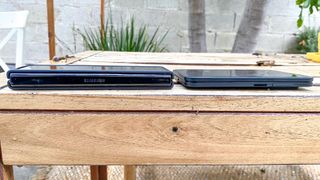
Winner: Samsung Galaxy Z Fold 3
Microsoft Surface Duo 2 vs. Samsung Galaxy Z Fold 3: Displays
With these phones, the true appeal — or gimmick, depending on your perspective — is the extended dual displays. The Surface Duo 2 features two separate 5.8-inch panels with a resolution of 1344 x 1892 each, or 2688 x 1892 together. Both screens have 90Hz refresh rates, which means smoother scrolling and higher frame rates in supported games. That could also come in handy when scrolling through documents, presentations, or spreadsheets.
The Galaxy Z Fold 3 unfolds into a 7.6-inch display with a 2208 x 1768 resolution and adaptive 120Hz refresh rate. It also has a 6.2-inch (2268 x 832) 120Hz cover display, which makes the Fold 3 a phone and a tablet.
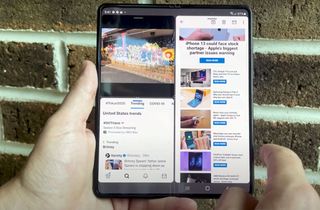
The Surface Duo 2 is certainly brighter, registering 672 nits on a light meter compared to 424 nits from the Galaxy Z Fold 3. Microsoft’s phone is more colorful, too, showing off 123.8% of the sRGB color spectrum to 104.2% for the Galaxy Z Fold 3. Colors appear about as accurate on either phone, though the Surface Duo 2 has a slightly better Delta-E score of 0.25 versus 0.26. (Numbers closer to zero are better.)

Yet, when watching video, like the No Time to Die trailer on YouTube, I know which phone I’d rather look at, and it’s not the one that has a noticeable gap in the middle. Video is just better on the Galaxy Z Fold 3, which also lacks the Surface Duo 2’s very noticeable bezels. That means when you shrink down the video to one panel, it feels decidedly cramped. The Surface Duo’s odd aspect ratio also makes it hard to expand videos to fill the full screen.
Winner: Samsung Galaxy Z Fold 3
Microsoft Surface Duo 2 vs. Samsung Galaxy Z Fold 3: Cameras
The Surface Duo 2 and Galaxy Z Fold 3 now find themselves on more equal footing when it comes to cameras. The original Surface Duo only had a single lens, but the new model offers triple rear cameras in a wide-angle, ultrawide and telephoto layout just like the Galaxy Z Fold 3.

Specifically, the Surface Duo 2 features a 12MP main camera, a 16MP ultrawide, and a 12MP telephoto with 2x optical zoom. Inside, there's a 12MP front-facing camera. The Galaxy Z Fold 3 has a similar lineup, with a 12MP main, 12MP ultrawide, and 12MP telephoto with 2x optical zoom. But where it leaps ahead of the Surface Duo 2 is that it has two front-facing cameras: a 10MP on the cover display and a 4MP under-display camera on the inside.
The Surface Duo 2 actually compares well to the Galaxy Z Fold 3 outdoors when the lighting is ample. I actually prefer Surface Duo’s photo of a fountain, as it's got the bolder, more accurate coloring. The Galaxy Z Fold 3’s shot got washed out, possibly because of over-exposure.
Switching to the ultrawide lenses for that same fountain, the Z Fold 3 redeems itself with a more balanced shot. While it’s a little darker than what the Surface Duo 2 produced, it manages to add texture to the back wall and tiles have greater depth. Our photo comparison tool crops the shots around the edges, but it’s worth noting that the Galaxy Z Fold 3 captures more detail, thanks to a wider field of view (123 degrees to the Surface Duo’s 110-degree FOV).
When the lights are low, you really see the strength of Samsung’s cameras, particularly when you have to switch to a night mode to help capture a shot. The orange lighting illuminating our Halloween decorations didn’t flummox the Galaxy Z Fold 3 the way it did the Surface Duo 2, where the entire cast of the photo has taken on an orange hue.
I’m more impressed by how the Surface Duo handled this portrait of my daughter, adding a pretty even background blur, even if it did catch her right shoulder a little bit. But the photo is well-lit unlike the overly dark Galaxy Z Fold 3 exposure. And Samsung has a habit of over-smoothing faces.
We’ve knocked the Galaxy Z Fold 3’s under-display camera for not delivering the sharpest of selfies, and that problem is on display here, where you’ll detect some fuzziness around my eyes. The over-aggressive face smoothing is on display here, too. And yet, I think the overall selfie from Samsung’s phone may be better than the shot produced by the Surface Duo 2, which struggled with sunlight streaming into the shot. As a consequence, it’s an overly warm shot that loses some of the details on the right side of my beard.
The cameras on the Surface Duo 2 are definitely better than their predecessor’s. But the Samsung Galaxy Z Edge 3 still enjoys an edge here, especially when the lighting is challenging.
Winner: Samsung Galaxy Z Fold 3
Microsoft Surface Duo 2 vs. Samsung Galaxy Z Fold 3: Performance and 5G
Another way the Surface Duo 2 is a step up from the original phone involves its predecessor. Instead of a year-old system-on-chip, Microsoft has turned to the same Snapdragon 888 that powers many of the best Android phones — including the Galaxy Z Fold 3.
Microsoft opted for 8GB of RAM for its new phone, while the Galaxy Z Fold 3 has 12GB. Considering that one of the hallmark features of the Surface Duo 2 is that it can run two apps side-by-side, we expected more RAM, especially in a device that starts at $1,499. 8GB is probably fine, though.

The extra memory does give the Galaxy Z Fold 3 an edge in some benchmark results, though. In Geekbench 5, Samsung’s phone posted a 3,418 multicore result to the Surface Duo 2’s 3,384 result. Graphics benchmarking was more or less equal, with the Surface Duo 2 posting 34.8 frames per second in 3DMark’s Wildlife Unlimited. The Galaxy Z Fold 3 produced 33.7 fps.
As for our real-world test, Surface Duo 2 pulled ahead by transcoding a 4K video file into 1080p using Adobe Premiere Rush. The Surface Duo’s 46-second time was 4 seconds faster than what we saw with the Galaxy Z Fold 3.

Microsoft added 5G to the Surface Duo 2, bringing it in line with other 2021 flagships, including the Galaxy Z Fold 3. More importantly, Microsoft’s phone supports both sub-6GHz and mmWave-based 5G networks. The Surface Duo 2 also has NFC, unlike its predecessor. Those features put it on par with the Galaxy Z Fold 3.
Winner: Microsoft Surface Duo 2
Microsoft Surface Duo 2 vs. Samsung Galaxy Z Fold 3: Battery life and charging
Foldables have a notable weakness: battery life. The cost of having devices that fold in half is reduced space for power packs. And dual screen devices have to keep two panels powered up. That can consume a lot of power.
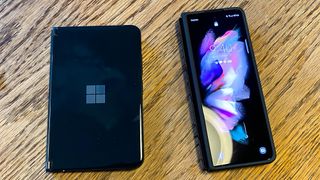
The first Surface Duo had a paltry 3,577 mAh battery, which led to an underwhelming result in the Tom's Guide battery test. The Surface Duo 2 tried to address this, with a bigger 4,449 mAh power pack. And it paid off, at least when we ran our battery test on just one display and got a respectable time of 9 hours and 47 minutes. But the Surface Duo 2 has two displays and running our test when both screens were active cut the time down to 7 hours and 38 minutes.
That’s still better than the Galaxy Z Fold 3, which rode its 4,400 mAh to a lackluster 7 hours and 52 minutes in the 60Hz mode and 6 hours and 35 minutes with the 120Hz adaptive refresh rate enabled.
For charging, the Surface Duo 2 supports up to 23W (up from 18W on the Surface Duo), while the Galaxy Z Fold 3 goes up to 25W. Neither phone ships with a charger, making it hard to compare charge times since you’re at the mercy of whatever charger you happen to have lying around.
Winner: Microsoft Surface Duo 2
Microsoft Surface Duo 2 vs. Samsung Galaxy Z Fold 3: Software and special features
A software comparison between two Android phones is usually straightforward, and indeed, both the Surface Duo 2 and Galaxy Z Fold 3 run on Android 11 out of the box. Samsung’s phone has a clearer path forward as One UI 4 based on Android 12 is already in beta and heading to Samsung phones around the end of the year. Microsoft will only say that it’s talks with Google to get an Android 12 update.
But the nature of the two phones means there’s a more pertinent issue to look at — how do the Surface Duo 2 and Galaxy Z Fold 3 let you get more work done. Both place a premium on multitasking, with each phone supporting a pairing feature to let you launch multiple apps at once. (The Duo’s implementation remains a little buggy for now.) While the Surface Duo lets you run apps side by side on different panels, the Galaxy Z Fold 3 goes one step further by letting you run up to three apps at once.
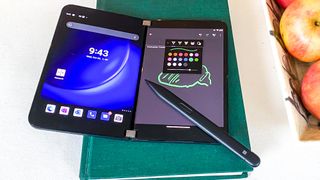
Microsoft has worked with many app makers to optimize apps for its dual screen. In these cases, one activity will fill the phone’s right panel while another takes up the left panel — say, controls appearing on one of the screens and the game on the other when you’re playing Asphalt 9. This sounds an awful lot like the Galax Z Fold 3’s Flex mode which turns the bottom half of the display into a control panel when you bend the phone in half.
In my experience, the Galaxy Z Fold 3 is better suited to boosting your productivity because it lets you use the full 7.6 inch screen. You can run an app across both panels on the Surface Duo, but you will have to contend with a gap running the middle, which to me is far more annoying than the Fold’s visible crease.
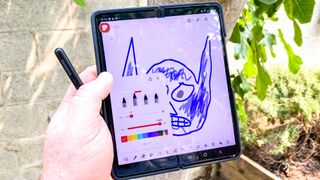
Both phones support optional pens — the S Pen Fold Edition in the Galaxy Z Fold 3’s case and the Surface Slim Pen 2 for the Surface Duo. (There’s a Bluetooth-based S Pen Pro as well for Microsoft’s foldable.) The merits of each stylus will have to be saved for a separate S Pen vs. Slim Pen face-off, but I found Samsung’s pen easier to use and supported by more apps. It also happens to be less expensive at $79 to the $129 Microsoft charges for the Slim Pen 2.
Winner: Samsung Galaxy Z Fold 3
Microsoft Surface Duo 2 vs. Samsung Galaxy Z Fold 3: Verdict
In a Microsoft Surface Duo vs. Samsung Galaxy Z Fold 3 battle, the one with the foldable display wins. Having a single continuous panel is the better productivity booster, and that’s the main factor to consider when you’re spending at least $1,499 on a phone.
| Row 0 - Cell 0 | Microsoft Surface Duo 2 | Samsung Galaxy Z Fold 4 |
| Price and availability (10 points) | 6 | 5 |
| Design (10 points) | 8 | 9 |
| Display (15 points) | 9 | 12 |
| Camera (20 points) | 15 | 16 |
| Performance (20 points) | 18 | 17 |
| Battery life and charging (15 points) | 8 | 6 |
| Software and special features (10 points) | 5 | 7 |
| Overall | 69 | 72 |
The Surface Duo 2 has its strengths with an elegant design, even if it is a hard phone to tote around. We appreciate the improvements to the camera and processor, not to mention the addition of features like 5G and NFC.
But the Galaxy Z Fold 3 is the more polished device, with more impressive multitasking features. It also helps that its S Pen is less expensive and more useful than the optional stylus for the Surface Duo 2.
There’s a reason we rate the Galaxy Z Fold 3 as the best foldable phone. And its reign is going to continue for a little bit longer.
Sign up to get the BEST of Tom’s Guide direct to your inbox.
Upgrade your life with a daily dose of the biggest tech news, lifestyle hacks and our curated analysis. Be the first to know about cutting-edge gadgets and the hottest deals.
Philip Michaels is a Managing Editor at Tom's Guide. He's been covering personal technology since 1999 and was in the building when Steve Jobs showed off the iPhone for the first time. He's been evaluating smartphones since that first iPhone debuted in 2007, and he's been following phone carriers and smartphone plans since 2015. He has strong opinions about Apple, the Oakland Athletics, old movies and proper butchery techniques. Follow him at @PhilipMichaels.

